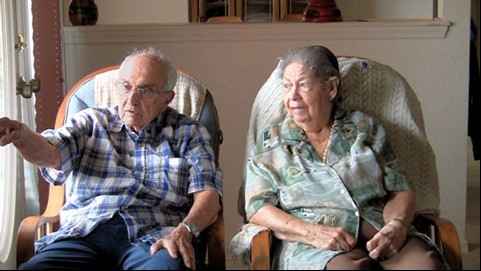If you had to sum up your life in 30 characters, what would they be?
She had no children, our 97-year-old aunt, though there are nieces and nephews aplenty, some by marriage, some by blood. When she died we came together, most of us strangers, to pay our respects to the former navy intelligence officer we called Tia Idalia, and to support her husband, our 99-year-old uncle, Tio Clemente. They were married for 67 years. A former army intelligence officer and immigrant from Cuba, he lived to care for her, but in the dark days following her passing, his health deteriorated rapidly. He suffered from pneumonia and grief, and the stark reality of a future without her. That's not to say he didn't see her still -- he says he did, across from him or next to him. He'd call her name, Idalia, and ask family and friends if they'd seen her too.
The funeral service at their church was scheduled and rescheduled over the course of 10 days. By the time Tio Clemente was hospitalized, most of the family had travelled back to their own homes, some as far away as Canada, before the service was held. During that time, he'd fallen mute and closed his eyes, as if a light had gone out. We debated how best to proceed and in the end, arranged for the church to come to his bedside. With the help of a case worker, he was moved into a private room, and the deacon, my husband and I, along with five of his neighbors all said our goodbyes to Idalia, each in our own way. Grief, it seems, is the same, regardless of your religion. As the only Jew in the room, I took surprising comfort in the makeshift Christian service unfolding. Throughout it all, our uncle lay unconscious, though the deacon told us later he saw him mouthing the words to The Lord's Prayer.
Idalia's hearing had deteriorated over the years, but no matter: she and Clemente knew exactly what the other was thinking. They still lived in their house. She managed the bills. He did the driving. They understood the risks. On a piece of paper, duct-taped to the dash of his car, was a note about who to call in case of an emergency -- the same neighbor who came to Idalia's aid when she failed to wake up from a nap on the day she died.
Papers were strewn across the dining room and kitchen tables -- bills, photographs, hand-written letters that spanned a lifetime, and his honorable discharge papers from the Army -- critical, we learned, to his being allowed to be buried next to her with his own headstone, when the time comes. The house was frozen in time -- a movie set from the 1960s with green velvet chairs in the living room, coffee still in the percolator, and her favorite sugar-free cookies in a worn, round Tupperware container on the counter, near the mustard-yellow chairs. Strewn across surfaces were dirty tissues, oxygen tanks, and her walker with the tennis-ball feet. I opened the front door and let the air waft through, the sunlight revealing the yellowed, torn carpet and stains of unknown origin.
The military burial site was a 45-minute drive from their Florida home, not far from a prison. As we approached the cemetery entrance, we were waved over to the side of the road and given written instructions. Our processional was comprised of four vehicles, one of which was the hearse carrying Idalia to her final resting place -- the U.S. flag, at her request, in full view at the rear. The papers detailed her plot information and what was to be inscribed on her headstone: her name, the day and year of her birth and death, and that she served in the U.S. Navy during WWII. Highlighted in yellow was the area of the stone we could contribute to. We had 30 characters, spread over two lines, to describe the essence of who she was -- and it needed to be returned within 48 hours.
A flutter of lovebugs invaded the site where the burial service was held. They landed on the coffin, clung to the flowers, and attached themselves to our car. A few ended up in my hair.
On the return drive, while our uncle lay unconscious in the hospital, the enormity of the responsibility hit me. This would be the final physical remembrance of a woman who served her country -- who lived a full life that I suddenly felt we knew too little about. That night, my husband and I traded ideas and phrases. Thirty characters amounts to five short words, at most.
In the end, it was the lovebugs that brought clarity.
When his time comes, our uncle will be buried beside her.
Tia Idalia's headstone will be engraved Eternally His.
And Tio Clemente's, Eternally Hers.
Earlier on Huff/Post50:


